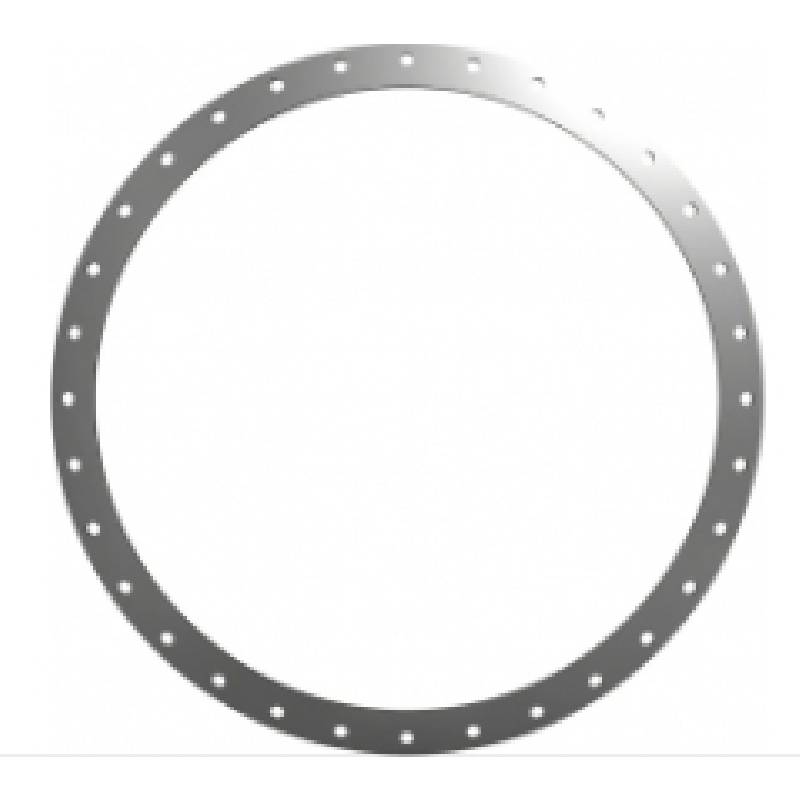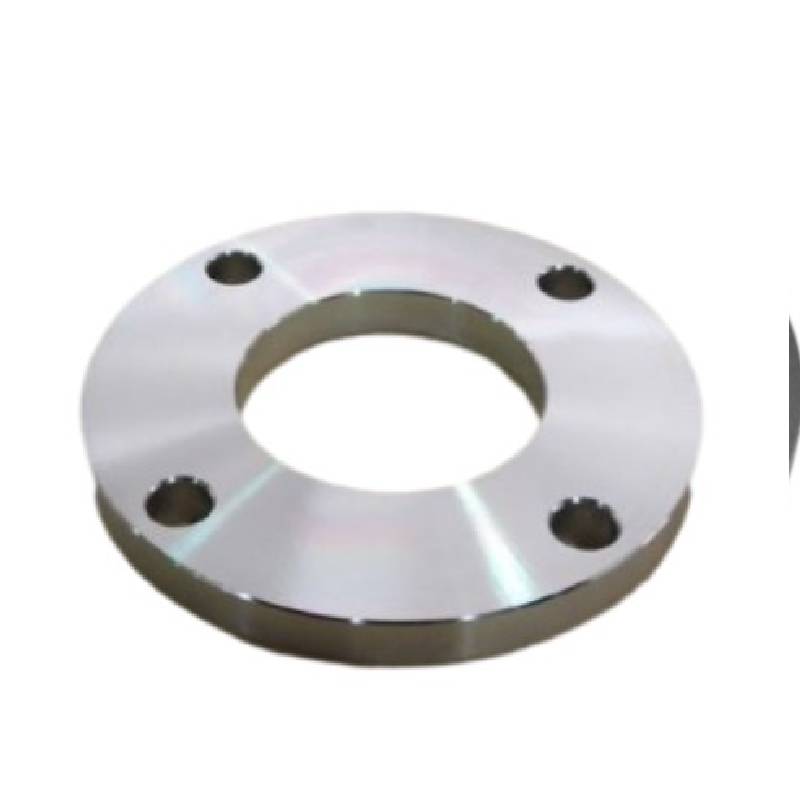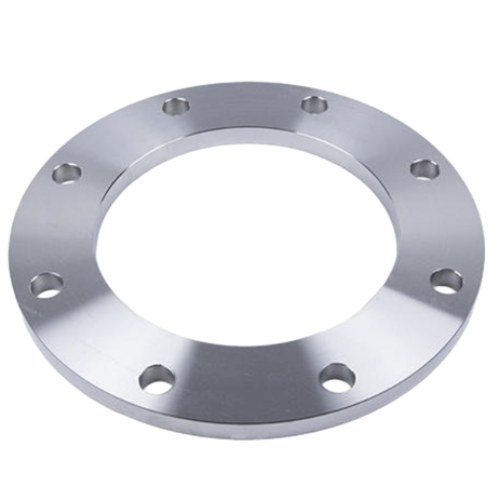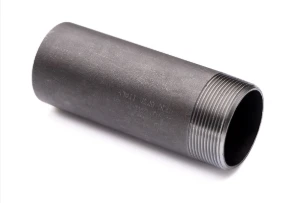-
Fortika Dezajno: La Plata Flanĝo DIN 86044 havas platan, cirklan platon kun egale interspacigitaj rigliltruoj ĉirkaŭ la perimetro. Ĉi tiu dezajno ebligas facilan vicigon kaj rigliĝon al la pariĝa flanĝo, provizante fortikan kaj stabilan ligon, kiu povas elteni la dinamikajn kondiĉojn spertajn en maraj medioj, inkluzive de vibroj kaj fluktuoj de premo.
-
Korodrezisto: Konstruitaj el altkvalitaj materialoj kiel karbonŝtalo, neoksidebla ŝtalo aŭ aloja ŝtalo, DIN 86044-Plato-Flangoj elmontras esceptan reziston al korodo, certigante fortikecon kaj longvivecon en maraj aplikoj kie eksponiĝo al sala akvo kaj severaj veterkondiĉoj estas oftaj.
-
Kongruo de marakvo: La Plata Flanĝo DIN 86044 estas specife desegnita por plenumi la striktajn postulojn por marakvaj aplikoj. Ĝiaj korodrezistaj materialoj kaj fortika konstruo igas ĝin ideala por uzo en marakvaj tubaj sistemoj sur ŝipoj, enmaraj platformoj kaj maraj strukturoj, kie fidindeco kaj rendimento estas kritikaj.
-
Precizeca Inĝenierado: DIN 86044-Plato-Flangoj spertas precizajn maŝinajn kaj inĝenierajn procezojn por plenumi striktajn dimensiajn toleremojn kaj surfacajn finpolurajn postulojn. Ĉi tiu precizeco certigas kongruecon kaj interŝanĝeblecon kun aliaj normaj flanĝoj DIN 86044, faciligante senjuntan integriĝon en marajn tubarajn sistemojn kaj minimumigante la riskon de likoj aŭ fiaskoj.
-
Facileco de Instalado: Instalado de DIN 86044-Plato-Flangoj estas efika kaj simpla, postulante simplan vicigon kaj rigliĝadon al la pariĝa flanĝo. Iliaj normigitaj dimensioj kaj dezajno faciligas facilan integriĝon en ekzistantaj maraj tubaj retoj, minimumigante instaladotempon kaj laborkostojn.
Ĉefaj Trajtoj:
- Fortika dezajno por maraj aplikoj
- Korodrezisto por fortikeco en marakvaj medioj
- Kongruo de marakvo por fidinda agado
- Precizeca inĝenierado por striktaj toleremoj
- Facileco de instalado kun simpla vicigo kaj boltado
Din 86044 Flange Dimensions
| Size (Inch) |
NB (mm) |
Pipo (mm) |
A (mm) |
B (mm) |
C (mm) |
D Number of holes |
E Diameter of holes(mm) |
F (mm) |
Weight (kg) |
| 10 | 250 | 273.0 | 276 | 335 | 375 | 12 | 18 | 16 | 6 |
| 12 | 300 | 323.9 | 327 | 395 | 440 | 12 | 22 | 16 | 8 |
| 14 | 350 | 355.6 | 360 | 445 | 490 | 12 | 22 | 16 | 10 |
| 16 | 400 | 406.4 | 411 | 495 | 540 | 16 | 22 | 16 | 11 |
| 18 | 450 | 457.2 | 461 | 550 | 595 | 16 | 22 | 16 | 13 |
| 20 | 500 | 508.0 | 512 | 600 | 645 | 20 | 22 | 16 | 14 |
| 22 | 550 | 560.0 | 563 | 650 | 703 | 20 | 22 | 20 | 20 |
| 24 | 600 | 609.6 | 614 | 700 | 754 | 20 | 22 | 20 | 22 |
| 26 | 650 | 664.0 | 665 | 750 | 805 | 20 | 22 | 20 | 24 |
| 28 | 700 | 711.2 | 716 | 800 | 856 | 24 | 22 | 20 | 25 |
| 30 | 750 | 762.0 | 767 | 860 | 907 | 24 | 22 | 20 | 27 |
| 32 | 800 | 812.8 | 818 | 900 | 958 | 24 | 22 | 20 | 29 |
| 36 | 900 | 914.4 | 920 | 1010 | 1060 | 28 | 22 | 20 | 32 |
| 38 | 950 | 698.0 | 970 | 1060 | 1110 | 28 | 22 | 20 | 34 |
| 40 | 1000 | 1016.0 | 1022 | 1110 | 1167 | 32 | 22 | 20 | 36 |
| 44 | 1100 | 1120.0 | 1126 | 1210 | 1266 | 32 | 22 | 20 | 39 |
| 48 | 1200 | 1220.0 | 1226 | 1310 | 1366 | 36 | 22 | 20 | 42 |
| 52 | 1300 | 1324.0 | 1326 | 1410 | 1466 | 40 | 22 | 20 | 45 |
The Advantages of DIN 86044 Flanges
When it comes to industrial applications, the DIN 86044 flange holds a significant advantage due to its robust design and superior functionality. These flanges are primarily used in piping systems, providing reliable connections that are both secure and efficient. One of the most notable benefits of the DIN 86044 flange is its compatibility with a variety of materials, including steel, stainless steel, and plastic, making it a versatile choice for manufacturers and engineers alike.
Moreover, the DIN 86044 flange excels in durability. Its design incorporates high resistance to pressure and temperature fluctuations, which is crucial for systems that operate under extreme conditions. This reliability translates to lower maintenance costs over time, as fewer replacements are necessary compared to less durable alternatives.
Another key advantage is the standardization of the DIN 86044 flange. Being conformant to international standards means that these flanges can be seamlessly integrated into existing systems, facilitating easy upgrades and expansions without the need for extensive redesigns.
In conclusion, the DIN 86044 flange stands out in the market for its strength, versatility, and compatibility. By choosing this flange, businesses can ensure that their piping systems maintain peak efficiency and durability, ultimately contributing to smoother operations and reduced downtime.
FAQs About DIN 86044 Flanges
1. What are DIN 86044 flanges?
DIN 86044 flanges are specific types of din flange that adhere to the standards set by the German Institute for Standardization (DIN). They are designed for use in various industrial applications, particularly those requiring reliable and secure pipo connections.
2. What materials are DIN 86044 flanges made from?
DIN 86044 flanges can be made from a variety of materials, including:
Carbon steel
Stainless steel
Alloy steel
Other materials are suitable for specific industrial requirements.
3. What applications are DIN 86044 flanges suitable for?
These flanges are commonly used in:
Oil and gas industries
Petrochemical plants
Chemical processing
Power generation
Water treatment facilities
4. How should DIN 86044 flanges be maintained?
Maintenance tips include:
Regular inspections for signs of wear, corrosion, or damage
Proper cleaning to prevent the buildup of contaminants
Ensuring bolts and gaskets are correctly fitted and in good condition
Following manufacturer guidelines for specific maintenance procedures
5. Can DIN 86044 flanges be customized?
Yes, DIN 86044 flanges can be customized to meet specific requirements, including modifications in size, material, and design to suit particular industrial applications.
DIN 86044 Flange Standard
In the realm of engineering and manufacturing, ensuring compliance with established standards is crucial for maintaining safety and reliability. One such standard that carries significant importance is the DIN 86044 flange standard. This German standard is widely recognized for its specifications regarding the design, dimensions, and performance criteria for flanges utilized in various industrial applications.
The DIN 86044 flange standard outlines the essential characteristics of common flange types, which serve as critical components in piping systems, pumps, valves, and fittings. These flanges facilitate the seamless connection of different sections of pipe, ensuring the integrity of the overall system. The standard specifies dimensions such as bolt-hole patterns, thickness, and outer diameter, which help manufacturers produce flanges that are interchangeable with others in the market.
One key aspect of the DIN 86044 flange standard is its focus on compatibility. By adhering to this standard, manufacturers can ensure that their flanges effectively align with those produced by other companies, thus minimizing the risk of leaks and failures in systems under pressure. The standard also includes material specifications, ensuring that flanges can withstand various environmental conditions while maintaining their structural integrity.
Furthermore, the adoption of the DIN 86044 flange standard enhances safety in industrial operations. By utilizing flanges that meet this standard, engineers and project managers can be confident that their systems are compliant with international safety regulations. This not only protects workers but also prevents costly downtime due to equipment failure.
Corrosion Resistance of DIN 86044 Flanges in Saltwater Environments
The use of DIN 86044 flanges in various industrial applications is widespread, particularly in marine and saltwater environments. Understanding the corrosion resistance of these flanges is crucial for ensuring the longevity and reliability of piping systems.
DIN 86044 flanges are typically manufactured from carbon steel or stainless steel, with the latter being the preferred choice for saltwater applications due to its superior corrosion resistance. Stainless steel grades, especially those with higher chromium and molybdenum content, offer excellent protection against pitting and crevice corrosion, which are common issues in saline environments.
The corrosion resistance of DIN 86044 flanges is not merely a function of the material composition but also depends on the surface finish and any protective coatings that may be applied. Proper surface treatment increases the resistance to corrosive agents present in saltwater, thereby extending the lifespan of the flanges. Moreover, regular maintenance and inspection can help identify early signs of corrosion, allowing for timely interventions to prevent significant damage.
When selecting DIN 86044 flanges for saltwater applications, it is essential to consider the specific environmental conditions, including salinity levels and temperature fluctuations. Engineers and procurement specialists must choose flanges that meet or exceed the required standards for corrosion resistance to ensure optimal performance.
In conclusion, DIN 86044 flanges provide a dependable solution for piping systems operating in saltwater environments when appropriate materials and precautions are employed. Understanding their corrosion resistance properties is vital for minimizing downtime and enhancing system efficiency. By selecting the right DIN 86044 flange and implementing a proactive maintenance strategy, industries can safeguard their assets from the detrimental effects of corrosion.
Installation Guide for DIN 86044 Flanges: Ensuring Proper Fit and Seal
When it comes to industrial applications, selecting the right components is crucial for ensuring efficiency and safety. Among these, the DIN 86044 flange has emerged as a favored choice for many engineers and technicians due to its robust design and compatibility with various piping systems. This guide aims to provide essential steps for the proper installation of DIN 86044 flanges, ensuring a reliable fit and seal.
Step 1: Preparation
Before proceeding with the installation, it’s imperative to inspect both the DIN 86044 flange and the mating surfaces. Ensure that both flanges are free from any debris, rust, or imperfections. Clean any remaining residue thoroughly to guarantee a proper seal. Additionally, check for alignment of the pipes, as misalignment can lead to leaks or failures under pressure.
Step 2: Gasket Selection
Choose an appropriate gasket suitable for your application and the medium it will carry. The gasket acts as a seal between the two mating flanges and is crucial for preventing leakage. For DIN 86044 flanges, it’s advisable to opt for gaskets that can withstand the specific temperature and pressure conditions they will face.
Step 3: Bolt Tightening
Once both the flange surfaces and gaskets are properly prepared, align the flanges and insert the bolts. It is critical to follow the recommended bolt-tightening sequence to ensure even pressure and a secure seal. The tightening should be done progressively, using a torque wrench to achieve the specified torque level for the DIN 86044 flange.
By following this installation guide, you can ensure that your DIN 86044 flanges are fitted properly and sealed effectively. The right installation practices not only enhance the reliability of your piping system but also extend the lifespan of the components involved. For further information or specific technical support regarding DIN 86044 flanges, consult with industry professionals to ensure optimal performance in your applications.


















